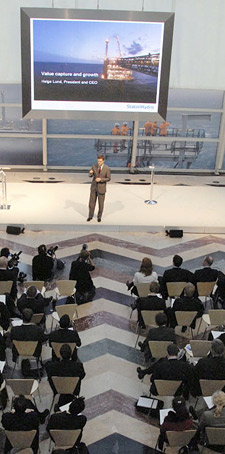
At its first Capital Markets Day since the merger of Statoil with Hydro’s oil and energy business, the group forecasts production growth and higher synergies from the merger than previously estimated.
“StatoilHydro will use its combined capacity and competence to continue growth and value creation. We will grow our equity oil and gas production from 1.9 million barrels of oil equivalents per day (boepd) in 2008 to 2.2 million boepd in 2012,” says chief executive Helge Lund.
“Our roadmap to 2012 should be seen as part of a bigger journey; the transforming of StatoilHydro into a global energy player,” says Mr Lund.
StatoilHydro foresees an increase both in Norwegian continental shelf (NCS) production levels and from its international upstream portfolio. NCS production is estimated at around 1.5 million boepd for the next ten years, reaching 1.55 million boepd in 2012. International equity production is estimated to grow to 0.65 million boepd in 2012.

Chief executive Helge Lund at the Capital Markets Day 2008. (Photo: Anna Littorin)
“Through the merger, we have gained a stronger global portfolio and a better position for future growth and value capture. Our financial and organisational capacity is enhanced, we access more competence and technology, and we have strengthened the group’s ability to mature projects and pursue business opportunities,” says Mr Lund.
StatoilHydro now estimates annual synergies from the merger at around 6 billion NOK before tax, 2 billion NOK higher than previously estimated.
“We have delivered strong results on the strategic positioning of the group over the last three years. Our strategic direction therefore remains firm. We will realise the full potential of the NCS while growing our international production. However we have not delivered fully on our short term production targets, and will subsequently strengthen our focus on short term deliveries and improved operational performance,” says Helge Lund.
Mr Lund maintains that an extensive exploration programme will be upheld as StatoilHydro’s preferred vehicle for long term growth. Technological innovation in defined areas where the company has a competitive edge will be used as a business enabler.
StatoilHydro’s position as a major supplier of natural gas and the integration between upstream and downstream to create value will be continued.
The group will approach the climate challenge with technology and industrial solutions, and develop a stronger position in the field of new energy, primarily focused on energy efficiency, carbon capture and storage, biofuels and offshore wind.
“The full value of the merger will be captured, and we are committed to realising the synergies. Good operational performance and visible growth, paired with a continuation of our dividend policy, will underpin a competitive shareholder return in the years to come,” says Mr Lund.
PRODUCTION: StatoilHydro will grow equity production from 1.9 million boepd in 2008 to 2.2 million boepd by 2012:
- On the NCS, equity production will increase from around 1.4 million boepd in 2008 to 1.55 million boepd in 2012.
- StatoilHydro aims at maintaining an NCS equity production level of around 1.5 million boepd for the next ten years.
- International equity production will continue to grow from the current level of around 0,5 million boepd to 0,65 million boepd in 2012.
StatoilHydro has chosen to use equity production to illustrate its growth ambition, since this is the only figure that makes production volumes comparable in physical, operational and financial terms.
In 2012, the group expects 75% of its international production to be subject to various types of production sharing agreements (PSA). High oil prices increase the profitability and speed of cost recovery, but they also increase taxation in kind and reduce the volumes entitled to StatoilHydro. At an oil price of USD 75 per barrel, PSAs are assumed to have an effect on entitlement production of around 150,000 boepd in 2008 and 240,000 boepd in 2012.
SYNERGIES: The merger has increased the group’s capabilities in most areas and thus serves to further strengthen competitiveness.
The merger between Statoil and Hydro’s oil and energy business was a forceful response to the challenges in the oil and gas industry. Through the merger, the group has enhanced financial and organisational capacity, gained access to more expertise and technology, and is developing a stronger global presence with a better global portfolio.
- The merger will deliver around NOK 6 billion in synergies annually before tax. This is related to StatoilHydro’s share. The gross benefit at StatoilHydro operated fields and facilities is estimated to be around NOK 12 billion annually.
- Annual synergies will amount to NOK 2 billion more than earlier communicated and thereby confirm the value capture potential of the merger.
- Some one-off, upfront restructuring costs will be incurred in order to realise these synergies. An after-tax estimate of these costs is 3 – 4 billion NOK.
- Full realisation of the synergies to be achieved within 3 – 4 years.
CAPEX: StatoilHydro estimates a capital expenditure (CAPEX) in 2008 of approximately NOK 75 billion and approximately NOK 80 billion in 2009. This is based on an assumption of 6 NOK/USD. Approximately 50% of the increase from 2007 is related to higher activity levels for sustaining existing production and supporting the group’s growth ambition, while the remaining is due to cost inflation, combined with gradually increasing project complexity.
RETURN ON AVERAGE CAPITAL EMPLOYED (RoACE): This metric is useful for balancing growth and returns, especially in today’s climate with high commodity prices, tight supplies and industry cost pressure. The group is committed to delivering a competitive RoACE when compared with its industry peer group.
DIVIDEND: StatoilHydro operates a firm financial policy intended to provide investors with a predictable direct yield on their ownership. It is intended to continue Statoil’s dividend policy by:
- returning an average of 45 – 50 per cent of net income directly to shareholders
- delivering a growing ordinary dividend each year
- employing share buy-backs as an integral part of the dividend policy
In recent years the company has delivered a total shareholder return that is highly competitive when measured against its peers. The average capital distribution since 2001 is 48 per cent of net income. The dividend policy will be combined with a strategy for reinvesting in profitable growth while retaining adequate financial flexibility.
EXPLORATION: StatoilHydro intends to achieve long term growth from a strong resource base with significant exploration activities worldwide. This year’s exploration programme represents an all time high for the new company, amounting to around NOK 18 billion, based on around 70 wells, split approximately 50/50 between NCS and internationally.
On the NCS most of the drilling activity will take place in mature areas, but there will also be frontier exploration in the Barents and Norwegian seas. Internationally, the most important wells will be in the US Gulf of Mexico, Brazil, Nigeria and Azerbaijan.
Drilling rigs have been secured for the entire 2008 drilling programme.
StatoilHydro’s presentations at the Capital Markets Day can be downloaded from the website www.statoilhydro.com/ir. The presentations can be seen and heard via webcast from the group’s website from 10.00 CET. The webcast will also be available on the website after the meeting.
Contacts:
Investor relations:
Lars Troen Sørensen, senior vice president for
investor relations, + 47 90 64 91 44 (mobile),
+47 51 99 77 90 (office)
Geir Bjørnstad, vice president, US investor
relations, + 1 203 978 6950
Media:
Ola Morten Aanestad, vice president for media
relations, + 47 48 08 02 12 (mobile),
+ 47 51 99 13 77 (office)
Kai Nielsen, public affairs manager,
+ 44 7824326893